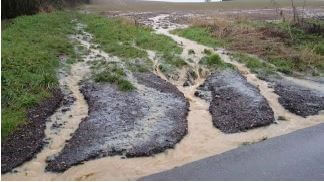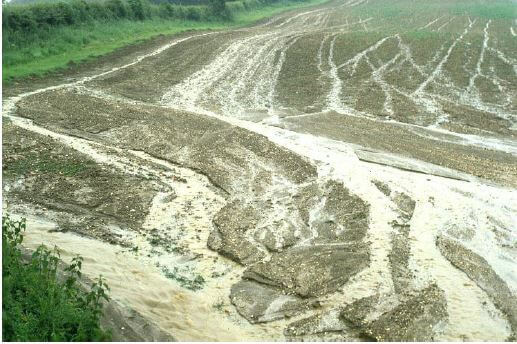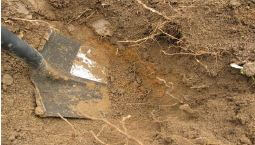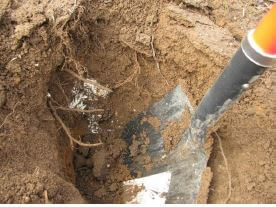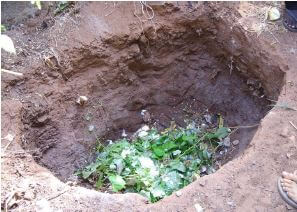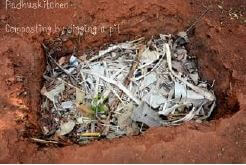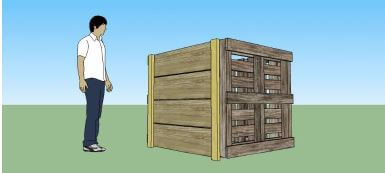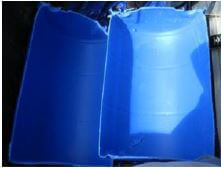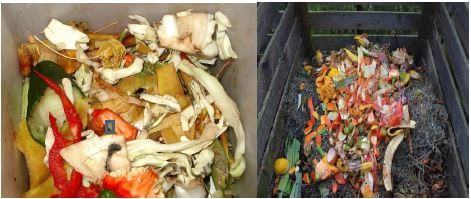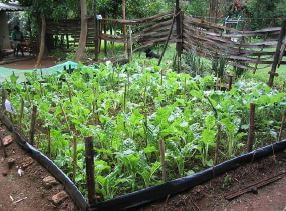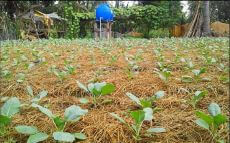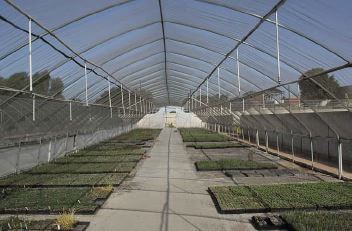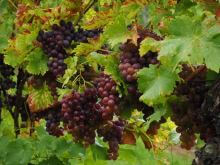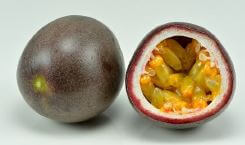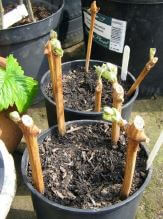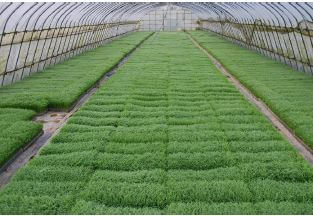
Soil Conservation
Soil recovery
- Soil is important in a number of ways. They Include:
- It’s our life support system
- It provides anchorage for plant roots
- It holds water and nutrients
- It’s a home for various micro-organisms
- We build on soil.
- Therefore soil plays a vital role in our environment. As without soil human life would be very difficult.
- It’s therefore a resource that should be guarded with a lot of caution. This is why to keep this resource in good we should limit chances of various factors doing away with it.
- Soil erosion is the removal of the top soil from one place to another by means of water, wind, or animal activities.
- Eroded soils by water are deposited to other places by siltation.
- Silt is the deposited soil and is rich in humor such soil very fertile. It comprises of organic matter and can be recovered. Silty soil is slippery when wet, not grainy or rocky
Soil recovery/restoration
- This is the process of collecting eroded soil from its deposition back to the farm for farming.
Importance of soil recovery
- Soil conservation is key to environmental sustainability
- It helps protect natural resources and watersheds,
- restores habitats for plants and wildlife,
- Improves water quality, and makes soil healthier.
- Soil conservation also creates economic opportunity.
- We should therefore look for eroded places and recover the soil and conserve our environment for the future.
- Runoff water is the water that runs on the ground at high speed and it removes the soil from its path leaving behind a gully.
- Soil eroded by runoff are deposited at the river banks, on the sides of the roads or in places where there are cover crops.
- Recovering soil is important to crops because it is very fertile, comprising of decomposed organic matter.
- Runoff water has the energy to detach soil particles by scour and to transport entrained soil materials either in suspension or by pushing or rolling larger particles.
(Runoff)
( soil deposition site)
Soil Improvement
- Soil improvement is the addition of soil nutrients to poor and non-productive soils. This can be done by addict organic manure.
Methods of soil conservation
- These include fallowing,
- using compost, manure, crop residues,
- Using fertilizer trees (e.g Calliandra and Pygeum africana),
- intercropping legumes with cereals and including the principles of conservation agriculture (crop rotation, ensuring permanent cover for the soil and no disturbing of the top soil layer).
- Organic manure can be prepared by the use of organic materials such as plants materials, animal waste, food remains or kitchen wastes.
- This can be done by the method of hip compost or pit compost.
- With hip compost, the organic materials are hipped on the ground and left to decompose for some time and then transported to the farm where planting takes place.
- In the absence of compost pit or residue pit, we may use drum or wood pallet as compost bin.”
- On the other hand, pit manure is prepared by digging underground and dumping all organic waste materials inside. These materials are left for sometimes to decompose then are used in the farm to improve soil.
(compost pit building)
(wooden compost)
(drum compost)
(compost heap)
(compost garden)
- Once the waste materials have decomposed fully we can plant a suitable crop in the waste pit.
- Dumping green and dry plant remains, food remains and kitchen wastes in a pit situated on a poor soil site is a god farming practice.
- This is because once the organic waste materials decay, they release nutrients that are required for the growth of pants.
- Therefore if an area has poor soil, it can be improved using organic manure, a crop can be grown successfully.
Importance of conserving soil
- The soil is literally the foundation of plant life. A tree will not be a tree without soil. While there are some plants that can live in water or air, most plants need to be rooted to the ground. It is the soil that provides nutrition to this plant life. It is through this vegetation that nourishes the humankind and the animal kingdom. Plants are important resource of food and fuel and of wood and other by-products that make our other life functions possible.
- The soil additionally supports the animal kingdom. Our agriculture also relies on soil, for its location and for other functions to be derived from its existence. It will be almost impossible to support the animal and human life without land.
- The soil is necessary for water supply. This is the magic of nature. The land is also necessary to ensure the quality of water we derive from our earth. Soil and water co-exist. So do we and soil co-exist? Taking good care of our soil equates to taking care of our water supply.

Water Conservation
- Water conservation is the process of retain water in the soil for planting. Water conservation can be done through mulching, shading, and cores cropping.
- Mulching
- Is the process of soil water conservation by spreading dry leaves or planting on the ground surface where the crops are planted.
- The dry leaves are called mulch where they are used to conserve soil water/moisture.
- Mulching prevents direct sunshine to the soil surface which lowers the rate or evaporation.
- Shading
- This is done by constructing a shade structure and covering its top with dry leaves.
- This is usually constructed on top of seedbeds to protect the seedling from the scotching sun and also to protect the soil from losing water through evaporation.
- Cover Cropping
- Cover cropping is the process of soil water conservation through planting short crops that spread wide on the ground.
- Plants used for cover cropping are bean plants, peas and green grams.
- Water just like soil, is an important resource in our environment for farming practices. We can use mulching, cover cropping and shading to conserve soil moisture.
- These farming practices reduce loss of water from the soil.
- Conserving water ensures that water in our farms is well used throughout the growing season
- It is important to conserve water because it is an important resource for farming in our homes. Without water, the plants will not grow to produce food for us.
- Mulching
Importance of water conservation
- Without fresh water you will die in just a few days.
- Conserving water is important because it keeps water pure and clean while protecting the environment
- Water conservation reduces energy use and can even save your household money.

Living better with wild animals
- Wild animals are very useful to use. Some are dangerous like the leopard and the lion.
Importance of wild animals
- Wildlife provides nutrients to humans
- People depend on wildlife for their livelihoods
- Wildlife has cultural significance
- Wildlife is important for the economy
- Protecting wildlife creates more jobs
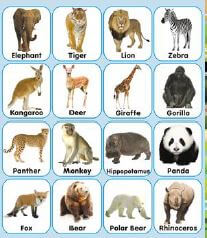
- Wild animals generate revenue through local and international tourism. Some animals destroy our crops and some kill our domestic animals.
- We can scare and keep away wild animals without killing them.
- We can keep away animals by the use sounds, using smells and use of smelly and bitter tasting plants.
- Use of Sounds
- Some animals are often scared by sounds made by people talking or shouting. Animals like monkeys and squirrels can be scared away by the use of sounds made by radio. A radio is switched on and put in a plantation to scare wild animals’ away.
- Using Smells
- Some wild animals are repellant to bad smells. Smells can be produced by burning items such as rugs, plastics or tires. This smell is used to keep away animals such as rodents.
- Use of Smelly and bitter tasting plants
- Some animals avoid smelly and bitter tasting plants. This method keeps away root eaters (rodents) such as the mole from destroying farm plants, and digging holes in the farm.
- Care and Safety from Wild Animals
- Some wild animals can be dangerous. They can attack us or even kill us, they include the wild dog, wild cat and monkeys. Such animals can also transmit dangerous diseases such as rabies. We should always keep a safe distances from wild animals. We should not touch or provoke wild animals.
- Use of Sounds

Growing Climbing fruit Plants
- Fruits are source of food rich in vitamins.
- They are important for our bodies for growth vitamins are nutrients needed by the body to repair warm out tissues.
- Climbing fruits plants have a stem called a vain. Vains are weak and therefore are needed to be supported using wood or wires.
- Such fruits plants can also be made to climb along the fence. They include the passion fruits, grapes, blackberries, kiwi fruits, raspberry fruits and gooseberry fruits.
How to Plant
- Climbing fruit plants can be planted from seeds or from stem cutting. Fruits seeds can be found from the market or can be prepared at home for planting.
- To prepare fruits seeds, get a fruit from a tree or from the market, extract seeds from it and wash.
- Dry the seeds on the sunlight and select the best seeds for planting. Prepare a seedbed and plant your seeds.
- Always water your seeds regularly until the seeds germinate. After germinating and the seedlings are strong, you can transfer them to their place of planting.
- This process of transferring seedlings from the seedbed to their place of planting is called transplanting.
Passion fruit seeds
- To prepare stem cutting select a sweet able fruit plant to get the stems form. Using a knife, cut the stem into small pieces of about one feet.
- Insert the cuttings into a planting site such as a container or a socket. Take care of the planted cutting by watering them, shading and removing weeds. When the cuttings start to develop leaves and roots, you can transplant them to their new places.
stem cuttings
(stem cutting)
- Young climbing fruits plants should be taken care of. We should make a shade of them to prevent them from direct sunlight.
- We should also construct a support structure using strong poles and wires for the fruit plant to support itself on.
- We also need to guide the plant along wires the process of guiding a climbing fruit plant along a wire is called Training.
Ways of training a plant
- A grower trains plants to:
- Improve flower or plant appearance and management,
- improve flower and fruit size and quality and
- to protect plants from damage.
- Training plants is done by:
- supporting,
- thinning,
- stopping,
- disbudding and
- pruning.
- Water the young fruit plant regularly and apply manure at its roots. Artificial fertilizer can also be used at minimal quantities to ensure safe food, protect the plant from any weeds by weeding them regularly by uprooting weeds from the stem.
Managing Climbing fruit plants
- This is taking care of the plant to ensure that it grows until the harvesting stage. The process of managing fruits plant include, watering, weeding, manure application, training and harvesting.
- This can be well achieved by developing a project schedule.
- The planted climbing fruit plant should be watered regularly on the established site.
- Weeding should be done to reduce competition from weeds for nutrients, water and light.
- It is important to make a shade over the young plants. The shade protects them from direct heat of the sun. It is important to make a fence around them.
- A fence protects them from being damaged by animals.
- Well-rotted manure should be applied from time to time to ensure that the fruit plants grow healthy.
- Climbing fruit plants also need to be supported so that they grow well and receive adequate light.
Harvesting
- Fruits can be harvested at their right time of harvest. Once the fruits are mature, they should be harvested. The right time for fruit harvesting can be determined by observing the colour of the fruit.
- Some fruits like the yellow passion fruit turn their colour to yellow and become a bit softer, smoother and sweet smelling. Some fruits such as the passion fruits fall of from the tree when they are ready for harvesting.
Harvesting Process
- Climbing fruit plant can easily be damaged during the harvesting process. We should take care not to pull the fruits from climbing fruit plant.
- Pulling the fruits can damage both the fruit and the plant. Tender fruits such as berries should be placed in small container immediately after harvesting to prevent damage.
Join our whatsapp group for latest updates
Tap Here to Download for 30/-
Get on WhatsApp for 30/-
Download Conserving our Environment - CBC Grade 5 Agriculture Revision Notes.
Tap Here to Download for 30/-
Get on WhatsApp for 30/-
Why download?
- ✔ To read offline at any time.
- ✔ To Print at your convenience
- ✔ Share Easily with Friends / Students

